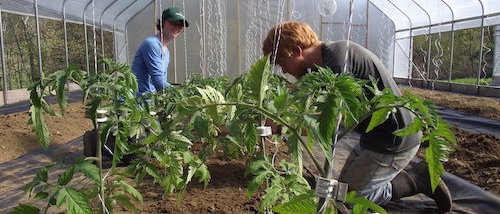Capturing the struggle behind the flowers
I’m not a flower farmer. Not even close. I live in Portland, Oregon, on a sloped and wooded lot, with only a few patches of grass that get sun. Even when I plant things there, they don’t thrive. I like to blame it on that stuff, but the reality is it’s probably just me and my formidable lack of skill.
But, in spite of my shortcomings in the garden department, surprisingly I have been telling stories about flower farming for five years now.
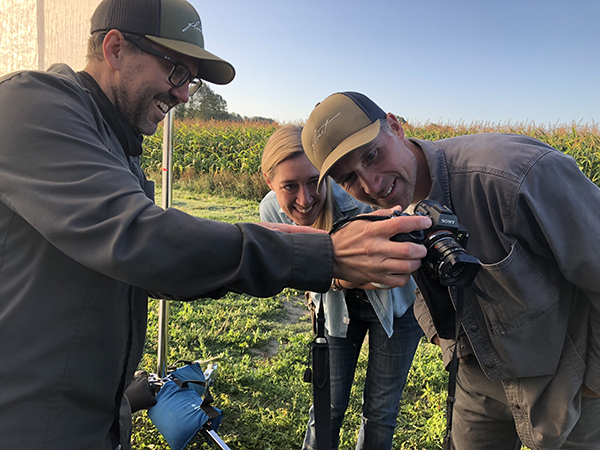
L to R is the author, the director of Growing Floret, who also worked on the forthcoming documentary series "The Beautiful Pursuit," with Erin and Chris Benzakein.
In the summer of 2019, I started filming the television show, Growing Floret. I was the director and my education in flower farming was about to begin under the tutelage of farmer-florist Erin Benzakein and the team at Floret. Thanks to social media, her book, “Cut Flower Garden,” her flower farming course and of course her articles in Growing for Market, she was one of the most well-respected and recognizable flower farmers in the world. Clearly, I was in over my head and honestly, I was not really that interested in flowers.
But I was interested in stories.
If you had told me then that in 2025, I would still be telling stories about flower farming, I would have laughed. At the time, I thought it was simply about growing flowers. What I’ve discovered over these years is that flower farming isn’t really about the flowers at all.
On the first day of filming, I sat down with Erin and her husband Chris to do a pre-interview. I had never met them face to face and I was just trying to get an idea of what their story was. They outlined a bit of their background, and I asked a bunch of naive questions about how things worked. I remember asking them to describe the work. How hard was it? What were the biggest struggles? Is it hot, muddy, buggy, freezing, what? Tell me what the worst days are like. It got immediately awkward. They tried to explain it in general terms and finally Erin just said something to the effect of, “we don’t really tell that story.” I did not know it then, but my education had just begun.

Phaedra Rodriguez, from Phaedra Gardeness in Australia is one of the growers featured in the film. Image courtesy of Phaedra Rodriguez.
In Season 1, we concentrated on a year of the farm’s transition and growth. Erin and Chris had recently bought land next to their original farm and were significantly expanding Floret’s footprint. We documented the day-to-day workings on the farm. Everywhere you looked it was like a postcard, and we did our best to represent that in the cinematography. They faced a handful of struggles, disease and powdery mildew, deciding if they still wanted to sell dahlia tubers and the stress of launching another book. And while we captured those challenges, it was always a little uncomfortable.
Along the way, I began learning the language of flower farming through interviews with Erin. Our on-camera conversations, planned for an hour, would often stretch to two or three as we explored deep questions about the value of beauty. Erin was open and honest, but there was one topic she often skimmed over: the struggle. When I asked about hardships, she would answer with beauty. We talked about hard work, but we never really dove into the guts of what farming demanded.
She would tell me that local flower farming was a “movement.” I accepted it, but internally I was skeptical. Was it a career? Absolutely. Was it a passion? I am sure it was. But was it really a “movement?” I was not convinced, Erin said it was, but 15 years of journalism left me cynical.
In Season 2 of Growing Floret, we took a different approach. Instead of documenting the farm’s day-to-day life, we explored bigger questions about legacy, and what it meant to live this one life. Exploring these ideas with someone as thoughtful as Erin made Season 2 the highlight of my professional life. It was also a year marked by more visible struggles - her breeding program stalled with sick plants and record-breaking wet weather. Erin agreed to share these stories, though I could tell it wasn’t easy for her. The tension between beauty and struggle remained.
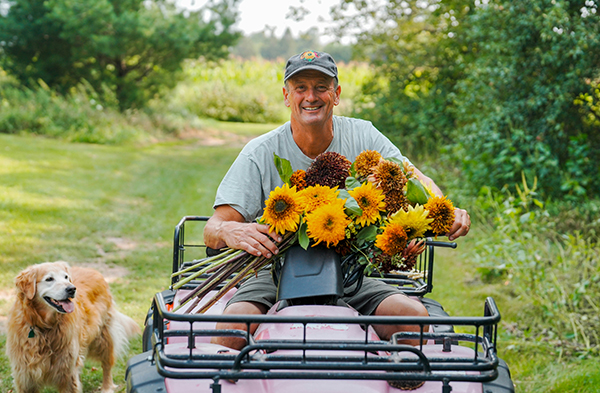
Also featuring in the film is Sunflower Steve from Sunflower Steve Seed Company in Wisconsin. Image courtesy of Sunflower Steve.
Over the course of both seasons, I had learned so much more about what Erin meant by “leading with beauty.” In the beginning, I thought it was just marketing - show the pretty pictures, hide the hard work, sell more flowers. But I was missing something fundamental. Erin saw herself as an “agent of the flowers,” an advocate whose role was to help them thrive - and not just her own flowers, but all flowers. When she talked about beauty, she wasn’t trying to cover up the struggles. She was trying to change how people saw the world - not just how it looked today, but how it could look if more people fell in love with growing flowers.
Early in her farming career, she had tried being more open about the hardships. “When I would talk to customers about how challenging it was,” she told me, “they would express feeling guilty buying from us. While in one way, it felt really good to have that acknowledgment, on the other hand, it was actually negatively impacting our sales, like in a measurable way.” That was bad for business, but more importantly, it was bad for the future of local flowers. She realized guilt wouldn’t inspire more people to grow flowers, but beauty could.
I began to see how this played out in real time as Erin, Chris and I decided to keep telling stories together. Customers who fell in love with Floret’s flowers would ask questions about growing their own. People captivated by photos of sunrise in the flower fields would seek out local flower farmers in their communities. More people growing flowers meant more people sharing flowers, more people treating the earth with respect, more people showing each other kindness. The beauty wasn’t hiding the truth - it was opening a door for more of it.
Then came one simple question that sparked a complex new project. Erin sent a survey to thousands of flower farmers, asking how Floret could help support them and their businesses to thrive. In the last few minutes before sending, she tagged on the question: “What do you wish people knew about flower farming?”
Responses poured in. They were farmers who had built successful businesses by sharing carefully curated images of perfect blooms and sunset-lit fields, just like Erin and others had taught them. They loved flower farming, had made it their life’s work. They pursued it not just as a career, but as a calling. Yet they weren’t feeling fully seen. They wanted to tell more of the entire picture - the physical toll, the financial tightrope, the countless sacrifices. They just couldn’t figure out how to do it without undermining everything they’d built.
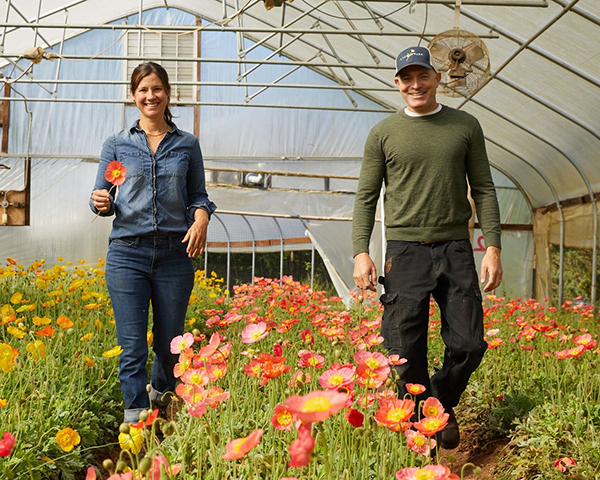
"The Beautiful Pursuit" covers quite a bit of ground, from Mandy and Steve O’Shea, owners of 3 Porch Farm in North Georgia (above), to Georgie Newbery, from Common Farm Flowers in the U.K. Images courtesy of 3 Porch Farm (above) and Georgie Newbery (below).
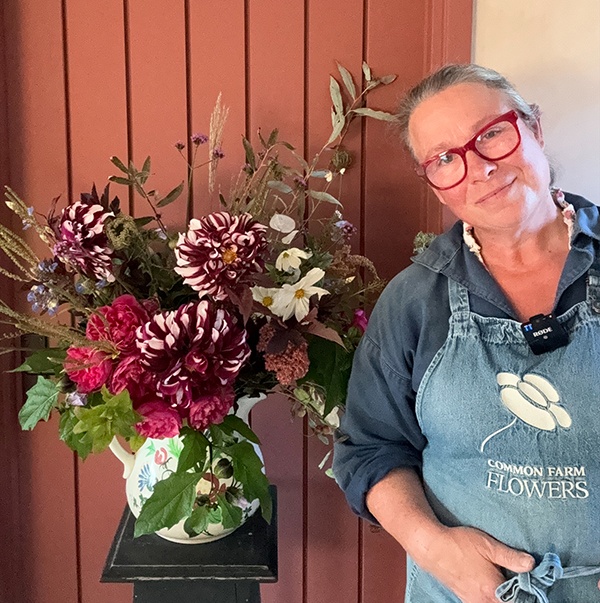
That’s when Erin realized these survey responses weren’t just data, but a collective voice waiting to be heard. What if we listened, and told this story? Individual farmers couldn’t risk sharing the harder truths, but if Floret made something, they could point to it to help educate their customers about the realities of flower farming. If we talked to enough farmers, no single person would have to bear the weight of the struggles. The story could speak for all of them - both the farmers in the film and thousands of others wishing to share this story.
From my garage office in Portland, I started conducting Zoom interviews with farmers around the world. No film crews, no fancy equipment - just conversations. I ended up talking to 38 farmers across 32 different farms for over 60 hours of interviews. Some had been at it for decades, others were just starting out. They shared their stories through cell phone videos, social media posts, and personal archives. Together with the interviews, we made a three-part documentary series called, “The Beautiful Pursuit.”
Through these conversations, I started to understand something new about beauty. These weren’t just stories of hardship, though the challenges were real and raw. They were stories of dignity and purpose. There was beauty in the flowers themselves, but more importantly in the deep soul-fulfilling choice to use your time on this earth to do good in the face of struggle.
One farmer would tell me about losing her entire crop to a flood, then immediately talk about the beauty of the one surviving flower. Another described working through a child’s illness, finding healing in the daily rhythm of tending her flowers. A veteran farmer spoke about teaching younger growers, passing on everything she’d learned, even though conventional business wisdom would say they were her competition.
Despite their varied backgrounds and circumstances, they shared this unwavering belief that what they were doing mattered - not just for themselves, but for their communities and the planet. Only by hearing from dozens of other farmers did I fully grasp what Erin had been trying to tell me all along. This truly is a movement.
And movements need stories.
“The Beautiful Pursuit” isn’t about the hardships. It’s about showing a different kind of beauty - one that exists in human hands as much as in the flowers they tend. It’s in the whole story: the perfect blooms and the failed crops, the sunrise moments and the midnight doubts, the Instagram-worthy bouquets and the mud-covered reality of creating them.
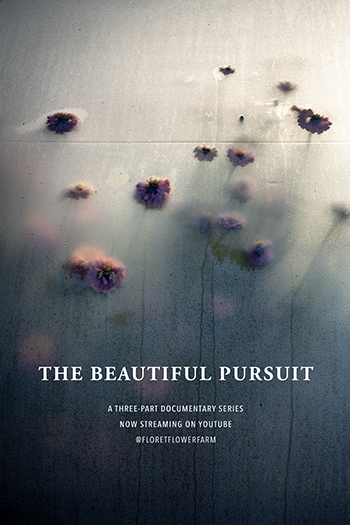
The Floret Original Film “The Beautiful Pursuit” will be available on YouTube, starting March 6th.
Now, when someone says, “Your job must be amazing,” flower farmers will have this series to share the deeper truth: “It is amazing - and it’s also this.” Because the most beautiful thing isn’t the flowers. It’s the people who grow them, and their unwavering belief that creating beauty is worth every struggle.
